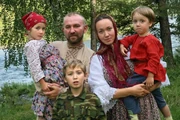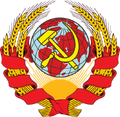| ||||||||
| Capital | Novocherkassk | |||||||
| Largest City | Rostov-on-Don | |||||||
| Other Cities | Krasnodar, Stavropol, Taganrog | |||||||
| Language Official |
Russian (Balachka) | |||||||
| Others | Armenian, Circassian, Ukrainian | |||||||
| Religion Main |
Eastern Orthodoxy | |||||||
| Others | Islam, Rodnovery | |||||||
| Demonym | Cossack, Cossackian | |||||||
| Legislature | Supreme Soviet | |||||||
| President | Alexander Tkachyov (DPSU) | |||||||
| Area | 236,744 km² | |||||||
| Population | 13,663,825 | |||||||
| Established | 1999 | |||||||
| Admission | 1999 | |||||||
| Time Zone | BAKT (UTC+3) | |||||||
| Summer | BAKST (UTC+4) | |||||||
| Abbreviations | SU-KA | |||||||
Cossackia (Russian: Казакия, Kazakiya), officially known as the Cossack Republic, is a republic of the Soviet Union located between the Black Sea and the Caucasus. The republic is hydrographically dominated by the Don River in the north and the Kuban River in the south.
The regions north of the Caucasus have historically been the homelands of the Cossacks, a group of mostly Eastern Slavic people who organized themselves into democratic and semi-military communities. Because of their location along the periphery of Russia, the Cossacks were historically regarded as guardians of the Russian frontiers. Under the Russian Empire, much of the lands under the control of the Cossacks were given special status within the Empire (e.g., the Don Cossack Host).
The Cossacks were among the first to fight against the Bolsheviks during the Russian Civil War, with the Don Republic and the Kuban People's Republic declaring their independence following the start of the conflict. These self-proclaimed republics would be absorbed into the Soviet Union early on, with the Cossacks being proclaimed ethnically Russian as part of the USSR's national delimitation (though Vladimir Lenin suggested that Cossacks were ethnically Ukrainians).
As part of Glasnost and the Parade of Sovereignties of the 1980s and 1990s, the Cossack communities in southern Russia began to demand the recognition of their culture and for greater autonomy within their areas. Both Russia and the Soviet Union initially ignored these demands, but over time would agree to discuss these issues. As the future republics of Alania and Circassia began to be established, a proposed Cossack Republic would also be discussed, with the region overwhelmingly supporting the movement. In 1999, the boundaries were finalized for the three new republics, with Cossackia to include the historic regions of the Don Republic and the Kuban People's Republic. In exchange for keeping the contemporary boundaries as they were (as well as transferring Sochi and the Shapsugs lands to the Republic of Circassia), the new republic would be allowed to include the Stavropol Krai (which historically was not completely Cossack territory). Cossackia officially became a republic in late 1999.

A traditional Cossack family.
Russians currently make up the majority of Cossackia, while those declaring themselves to be Cossacks make up slightly less of the population. Armenians, Circassians, Georgians, and Ukrainians are the largest minorities within the republic. Russian is the official language of Cossackia, with Balachka being the standard dialect. In recent years, many have supported the establishment of a separate "Cossack language," though nothing has come of which. Armenian, Circassian, and Ukrainian are also spoken within the republic. The majority of the population adhere to the Eastern Orthodox Church, with those adhering to Islam and Rodnovery forming a considerable minority. The economy of Cossackia is dominated by agriculture, commerce, industry, mining, and tourism. Cossackia has politically been dominated by the right-wing Democratic Party since its formation (with the Communist Party having support within the Krasnodar Krai).
| |||||||||||||||||




